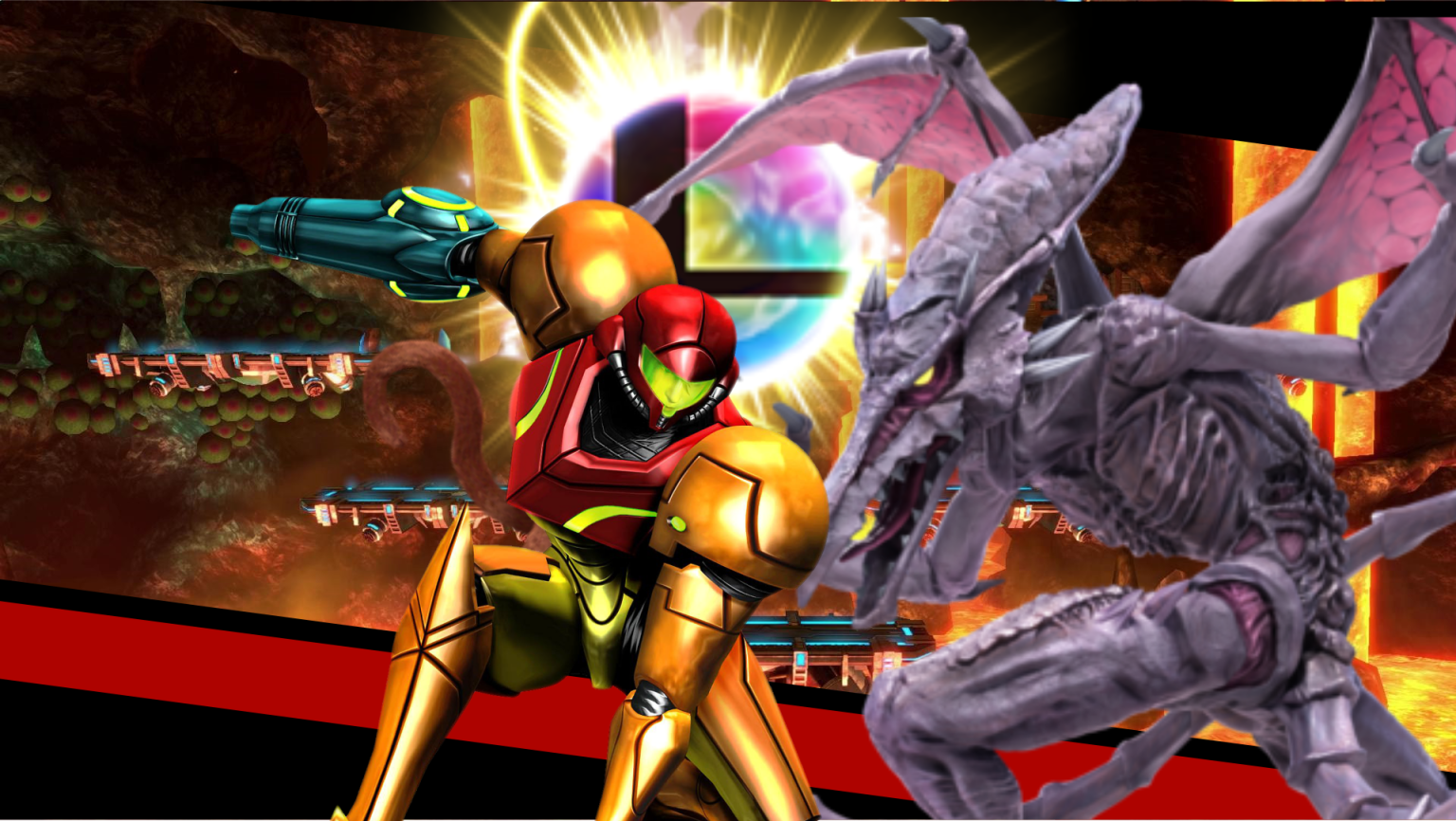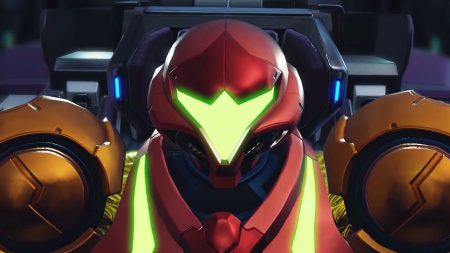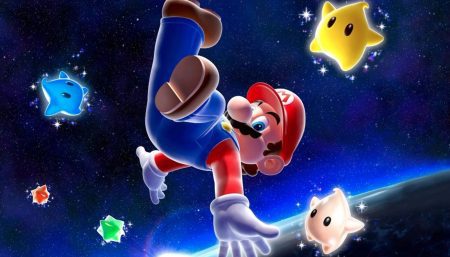Size Doesn’t Mean Everything
The reason that Super Smash Bros. works is because Nintendo has a vast catalog of intellectual properties to pull from. As I stated when I started this challenge, I haven’t played many games from the roster. Through cultural osmosis over time, I picked up a basic understanding of the worlds and stories of most: I know Mario jumps, I know Link is the “Hero of Time,” and I know Kirby is just really cute.
I also know that Ridley is too big for Smash.
Of the games that I would consider to be Nintendo’s most prominent, the Metroid series is probably the one I know the least about. I am aware that the series lends its name to the other half of the Metroidvania subgenre, and I know that there are animals that speedrunners save or kill.
The Metroid series has always just been there. I’ve always been aware of its existence, and have known that it would probably be my cup of tea thanks to my love of Castlevania. For whatever reason, I always just sort of steered clear. Well, today we’re grabbing the steering wheel and veering off into space to finally experience the Metroid games in all their glory.
Metroid
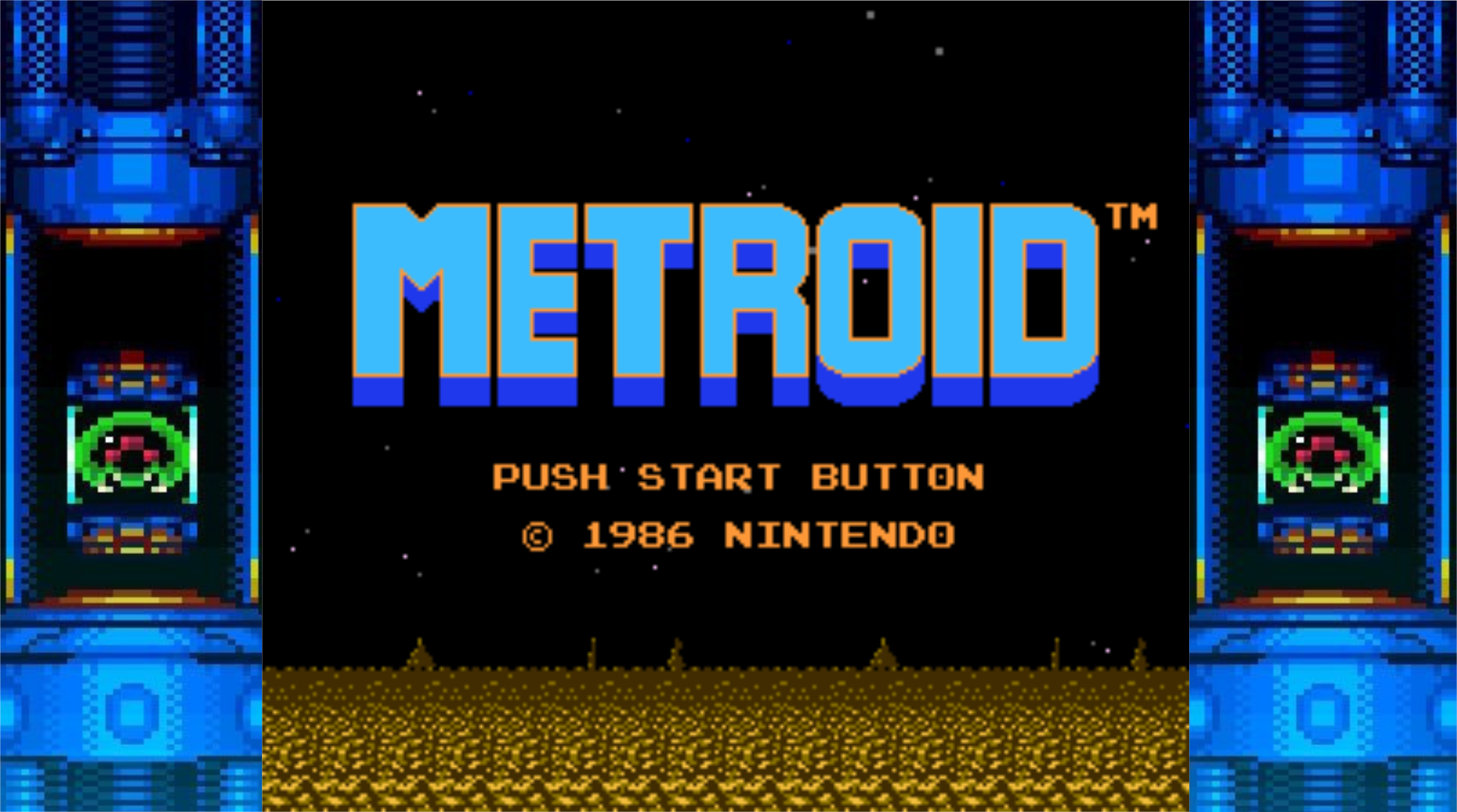
Let’s begin with my favorite complaint: the lack of story. Metroid actually has a ridiculously deep plot. In the year 2000, a Galactic Federation created a bounty hunting system to help deal with space pirates. Sometime in the future, a space research facility discovered a suspended life form that they referred to as Metroid. During shipment of the Metroid, it was intercepted by a group of space pirates, who intended to allow the Metroid to duplicate so that it could be weaponised. A bounty was placed, and legendary bounty hunter Samus Aran was sent out to be all heroic and save the galaxy.
I’m abridging the information in the manual; of course, this much information could never really fit onto an NES cartridge. The version we get in game is even shorter than that. Before the game kicks off, we’re given Samus’ mission: Go to the planet Zebes and defeat the now-duplicated Metroids, along with Mother Brain.
I appreciate the effort, but I have one issue with this telling. Who am I, and why am I the one to deal with this? Of course, now we recognize Samus as the badass bounty hunter she is. Without the manual, I didn’t initially get that. I think just adding in “Contacting Bounty Hunter Samus” or something before the mission would fit the tone and give me everything I need to understand the upcoming story. Tiny gripe, but it lingered with me while I played.
Into Darkness…

We open on a dark cave and see our avatar, clad in power armor, slowly warp into the world. This intro really helps to set the tone, and is probably the best part of this game. The planet of Zebes is a dark, hostile world filled with creatures that want to murder you. Samus is alone; you are helpless. You have to explore a labyrinth within the planet to succeed, and it really makes you feel alone.
And I think that feeling of solitude really suits the sci-fi genre the game wants to echo. The stylistic limitations of the console make it hard to really emphasize the fantasy of another world, but Metroid tries its hardest. The inhabitants of Zebes are all designed well; they are simple, but warped enough to feel alien. Certain zones also really feel like alien planets. The volcanic Norfair feels especially unique, with weird purple and green egg-like bubbles forming the walls.
But from here on, I’m going to struggle to find positive things to talk about.
I did not have fun playing Metroid. To be blunt, I actually really hated this game.
We should start with the gameplay. The game is incredibly formative, paving the way for the Metroidvania sub-genre, a personal favorite of mine. The Metroidvania genre focuses on exploration: The player will find themselves in a large open map that they are free to explore at their own speed. As the player explores, they will acquire new abilities and items, which can then be used to access more of the map.
What Makes a Metroidvania?
In my eyes, there are two major components required for a good Metroidvania. First, the map must be fun to explore. I want new areas that pull me in and make me want to see every corner. This style of exploration can generate real curiosity. When I arrive at an obstacle I know I can’t pass yet, it sticks in my mind. Eventually I’ll find the item that I need to pass that physical barrier, and that lingering curiosity turns to excitement.
The second component is the power-ups. I need to collect items that feel really fun to play with. My progression in a Metroidvania is tied to the abilities I gather during my mission, so they should be rewarding. There are exceptions: Extra health and ammo pick-ups will never be exciting, for example, but nearly always feel welcome.
I don’t think Metroid succeeds on either of those criteria.
The world is so confusing to traverse. I assume the issue is with system limitations once more, but not enough is done to differentiate different chambers. So many rooms were practically identical, not just in layout but in design. Little things like enemy layouts are often repeated, making rooms feel repetitive to play through. Worst of all however is how easy it is to get lost because of the repetition. I resorted to drawing out a map and I feel like that was the intended mode of play.
Honestly the tactility of pen and paper exploration was probably the most fun I got out of Metroid’s world. I love puzzle games and have multiple notebooks dedicated to mad scrawlings trying to discover solutions. Drawing a map was fun, but it never felt like part of the game; it felt like an oversight. The system limitations meant that each screen couldn’t be unique; instead, a copy/paste approach was taken. That makes the world feel sluggish to play through. Completing a room should lead to a new challenge, never a repeat of the challenge you just conquered.
Talking about the exploration also means I come face to face with my other NES hatred: poorly hidden secrets. So many games rely on hidden passages that rely on trial and error to discover. Metroid is filled to the brim with ridiculously hidden areas that require using the morph ball bomb to discover.

Once again, I had to resort to a guide to navigate the game. If secrets were hidden in these impossible to find passages, that would be alright. Still frustrating in nature, granted, but I don’t need to find them in order to progress. Of course, that’s not the case. Some game-progressing areas are hidden away. The first time I got really lost, I tried my hardest to figure out the way to progress naturally. I took a breath and retraced my tracks over and over. I eventually gave up, googled it, and discovered that I had to fall through a pool of acid that was fake.
Toxic floors in this game, whether acid or lava, are really punishing. They quickly drain your health and make movement difficult. If you don’t get out quickly, then there’s a high chance that you’ll die. I learned that the hard way early. I made mistakes, rushed through an area, and was punished for it. From that point onward, I avoided the floor like a toddler jumping between furniture.
Falling through a fake floor to progress is not good exploration. It requires me to actively hurt myself jumping into every pool I find to figure out which ones are real. In a difficult game where your health is incredibly valuable, this actively punishes exploration. If I want to find every secret the game has to offer without a walkthrough, I must take damage. There needs to be an indicator for what is safe and what isn’t, and Metroid failed to provide.
Energy, Missiles, and Laser Beams
The power-ups are a different kettle of fish. Some of them are fun and unique. The morph ball and the screw attack are by far the coolest and most interesting, and I will also place the ice beam on the “cool power-ups” list. For one, the pun potential isn’t missed on me. Secondly, it does open up new and interesting platforming challenges by freezing enemies and turning them into platforms.
The rest don’t sit well with me.

Let’s start with minor power-ups. Scattered across the planet are a bounty of ammo and health upgrades. Each energy tank you receive increases your max HP by ninety-nine, while each missile pack you find increases the maximum you can hold by five. These sound super useful, right? Well… Kinda. Both of these power-ups in isolation are really great. However, certain aspects of the game really undermine the satisfaction of powering up Samus.
When you hit game over in Metroid, you respawn at the start of the area with thirty HP. In order to reach your maximum again, you’re going to have to grind. Enemies occasionally drop missiles or health on death. If you die in Metroid, which you will a lot, you effectively get locked out of the game for five minutes. In later segments of the game, enemies will deal around twenty damage if they hit you. Starting at thirty HP means it’s ridiculously difficult to continue before you’ve backtracked and grinded for twenty minutes. It’s not fun.
Missiles are used to open some doors. You also need them to kill bosses. This means that until you have a reasonably large ammo capacity, you’re not going to want to use your missiles in case you come across a door or finally uncover the area’s boss. I really dislike games that give me something powerful and cool and make me scared to use it.
How to Shoot Aliens 101
I really did feel the lack of power in this game. For the most part, it was fine, as it felt like a tonal decision. However, clearing rooms of basic enemies could be frustrating at times. A lot of enemies are positioned on-screen slightly below where you can actually aim. Samus is slightly too tall to fight a lot of enemies and cannot aim down nor crouch. However, most enemies can be manipulated into a position where you can kill them.
Samus’ arm cannon can be upgraded three times. The first makes it actually usable by increasing the range, something you should just have from the start honestly. The second pickup is the ice beam, which I love, as it lets you freeze enemies and projectiles and then use them as platforms. This is the sort of exploration tool the game needs more of, as it lets you reach new heights using inventive enemy placements.
The third power-up is the wave beam. The wave beam is the final power-up to your cannon, allowing you to pierce through walls and platforms. It’s the sort of weapon that looks and feels amazing to fire off. I found it just after I beat Ridley, the second of the game’s bosses and the final hurdle before you access the end of the game. Off I pop to fight the final boss, equipped with a new, all-powerful toy. I descend an elevator and I come face to face with the titular enemy of the game, a Metroid.
And it completely destroys me. I try again and again before I resort to my walkthrough once more. Turns out, in order to kill a Metroid, you have to shoot it five times with your missiles… After you freeze it. The wave beam, this super cool weapon I had only just found, was useless because I couldn’t complete the game using it. I get that I was probably supposed to find it before fighting Ridley, and then swap back to the ice beam. No matter what the intent was, this felt like I was being robbed of one of my power-ups, one of the core elements of a Metroidvania.
I found the ice beam really early. I cleared around two thirds of the game before I finally found the upgrade, only to learn that I wasn’t allowed to use it. This was such a huge let down. I had been craving something as powerful as the wave beam for a while, only to have it snatched away instantly.
Some Aliens are Bigger Than Others
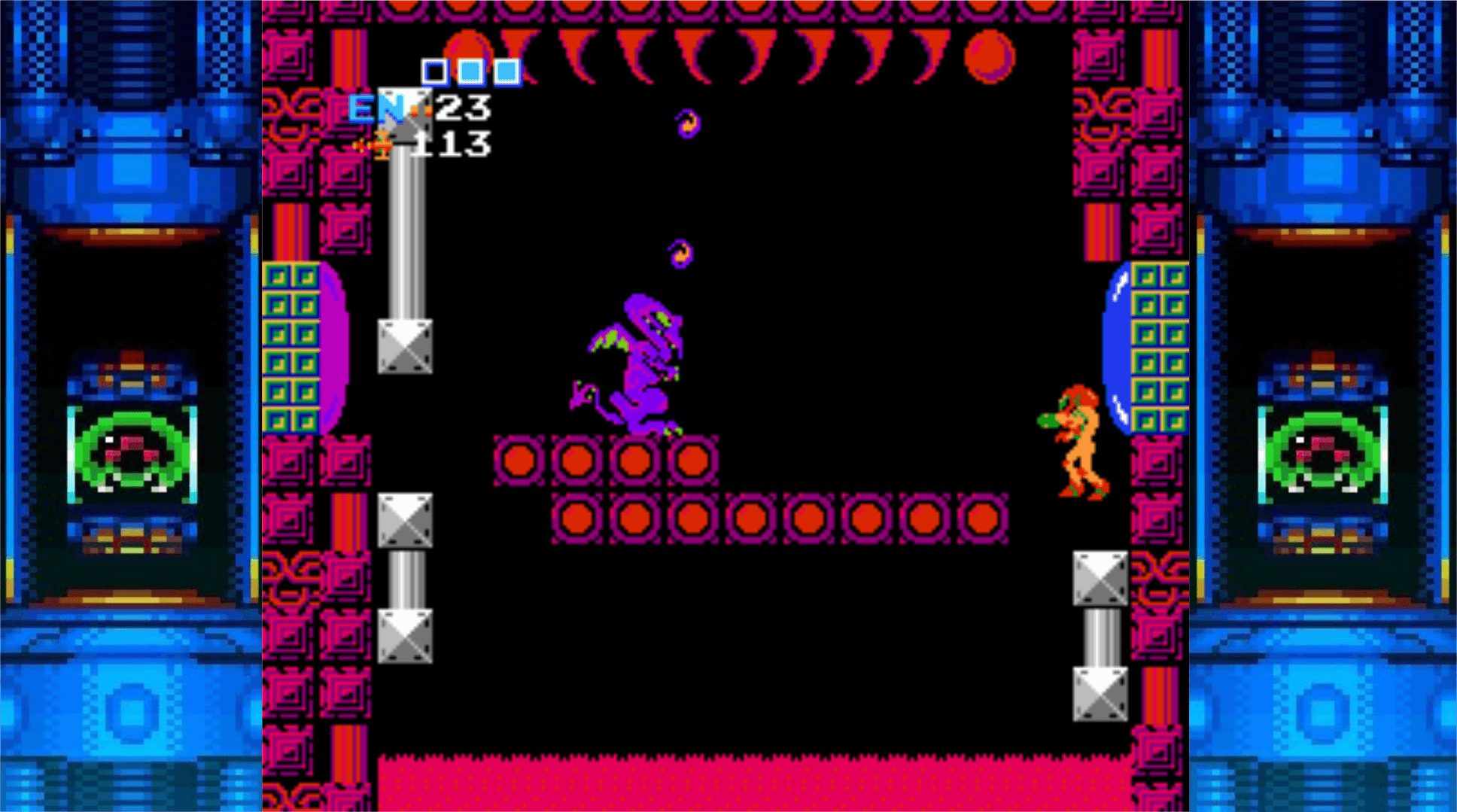
The bosses, on the other hand, are total cow-poop. They are random bullet-hells with no respite or safe patterns you can learn. Instead, they cram the screen with projectiles that do ridiculous amounts of damage and require no skill. I wound up just collecting enough health that I could tank all of the bosses’ hits and spam missiles until they died.
This is not a fun way to fight a boss. I tried and tried to take things methodically, but the game refused to let me play it fairly. Resorting to cheap tactics wound up being the easiest way and removed a lot of enjoyment from the game. Boss fights should serve as a test for the player—something to prove that they have mastered a game’s mechanics. Bullet-hells are not a genre everyone enjoys, but I think there’s a lot of enjoyment in the quick reactions and precision.
These boss fights aren’t even fun bullet-hells. They are tough slogs through randomly generated insanity, all of which do way too much damage and can block you from actually hitting the boss in question. It’s hard to capture the unfairness in a screenshot, but I did not feel like there was any mechanic to the fights. My only real option was to blindly spam missiles until either of us ran out of health.
Graphics – 5/10
Music – 4/10
Gameplay – 1/10
Fun rating – 1/10
Overall – 2.75/10
I really wanted to like Metroid. Some games show their age in charming ways. They may be a little rustic around the edges, but are ultimately like talking to your granddad about the war: They may rattle on in annoying ways, but it’s always nice to see them excited about something. The ideas are here, but the limitations of the console and artificial lengthening through difficulty turn this game into a slog.
I will also mention briefly that Metroid did have a remaster of sorts. When talking to a friend who loved the series, he tried to push me towards playing Metroid: Zero Mission. It’s a retelling of the story with more modernized gameplay (according to Wikipedia). I decided against it, as I wanted to have a feel for the series’ origins to see how it grew from there.
And it did grow.
Super Metroid

Super Metroid opens with Samus answering a distress call. She arrives on the station where the last known Metroid specimen was being studied, and discovers that the base has been attacked. You enter a dark chamber and come face to face with Ridley. After a short boss fight, Ridley grabs the Metroid and flies off, initiating the base’s self-destruct sequence.
This intro is bad-ass. It establishes so much with so little. We meet Samus in an intro cutscene. She explains her history with the space pirates and Metroids, which makes the game instantly accessible. We then establish tone by creeping through an abandoned facility littered with bloody corpses. Finally, we get two action sequences that demonstrate combat and platforming, both of which feel really cool. This might just be one of the best introductions to a game ever.
Tonally, this game is on point. Actually, it has made me re-evaluate how I’ve been scoring the games so far. I’ve been classifying the sound design of a game under “Music,” but I’m going to be changing that category to “Sound Design” from now on. Super Metroid doesn’t really deliver in terms of music. None of the tracks really stuck out to me; I wasn’t humming the music afterwards, but that’s kind of the point.
If Giger Made a Game.
The sound design of this game is reminiscent of a good horror flick. It’s heavy on the bass, focusing on an eerie atmosphere more than anything else. The backing of this game is designed to build up on the atmosphere while remaining unnoticed. You barely notice the music, but it’s always there, building tension and unease. It’s really quite clever.
With the soundtrack taking a backseat, the graphics of the game are left to carry a lot. I enjoyed the designs of the enemies in Metroid, but they pale in comparison to Super Metroid’s weird, gross creatures. I like playing games in order of release. Playing chronologically across multiple consoles allows you to see ideas flourish as technology and imagination combine. Everything looks so alien. If Castlevania was a love letter to old classic horror films like Dracula, then Super Metroid harks back to the like of Alien.

There’s a surprising amount of body horror in Super Metroid. Everything is fleshy and bulbous, in uncomfortable ways. Bosses especially are warped beyond recognition, covered in ooze and sores. This game is gory and gross. Flesh melts away in acid, aliens will capture you in webbing, and there’s also a space dragon.
This actually raises a pretty interesting point for me personally. I don’t really like Ridley. There was a lot of hype this character had to live up to. Before playing the game, I only really knew of Ridley’s existence for one reason: People wanted him in Smash, badly. However, at this point in my adventures through the Metroid franchise, Ridley really underwhelms. He’s just a dragon… but in space. Compare him to Kraid—monstrously tall, spewing spines and weird claw-missile things—or Crocomire, a mass of bulbous, fleshy growths. Of the many amazing boss designs in Metroid, I just find Ridley to be one of the more boring ones.
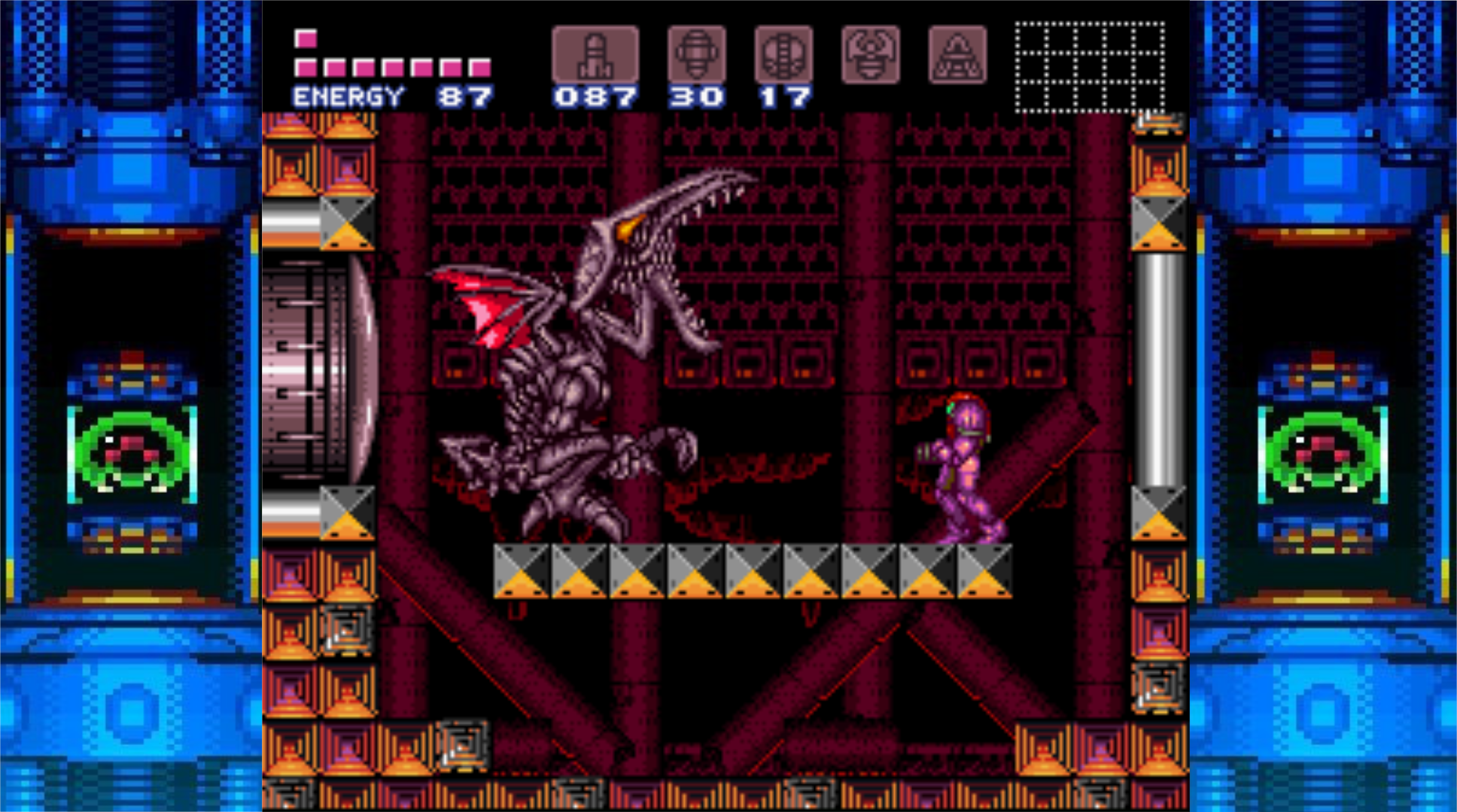
Anyway, stylistically this game ticks every box for me. It sets out to achieve a certain tone, and every element helps to tie that tone together. More importantly than that is the gameplay. So much has been done from the first in the series to improve upon the formula.
The Planet Below
Exploring Zebes is a joy. Not all zones are created equal (Maridia especially can sod off), but unlike Metroid I wanted to see every corner of the world. Each individual room has thought put into it, from enemy placement to the platforms. It means that it’s easier to navigate the world, as something about each room stands out. That being said, the upgrades in hardware also allows for the addition of an in-game map. Gone are the frustrations about getting lost backtracking. Instead I get to fully commit to the fantasy of being lost on a planet, with none of the annoying bits.
And I did get lost, in the best way. The planet is full of amazing set-pieces, making exploration a true pleasure. There are amazing examples of seeing something unique in the game that you can’t interact with. In most games, that might be a type of switch or a tunnel, but in Super Metroid it’s so much more. You’ll find eerie statues and grotesque gateways that burn themselves into your mind. I can’t remember other games where the scenery sticks around so well.
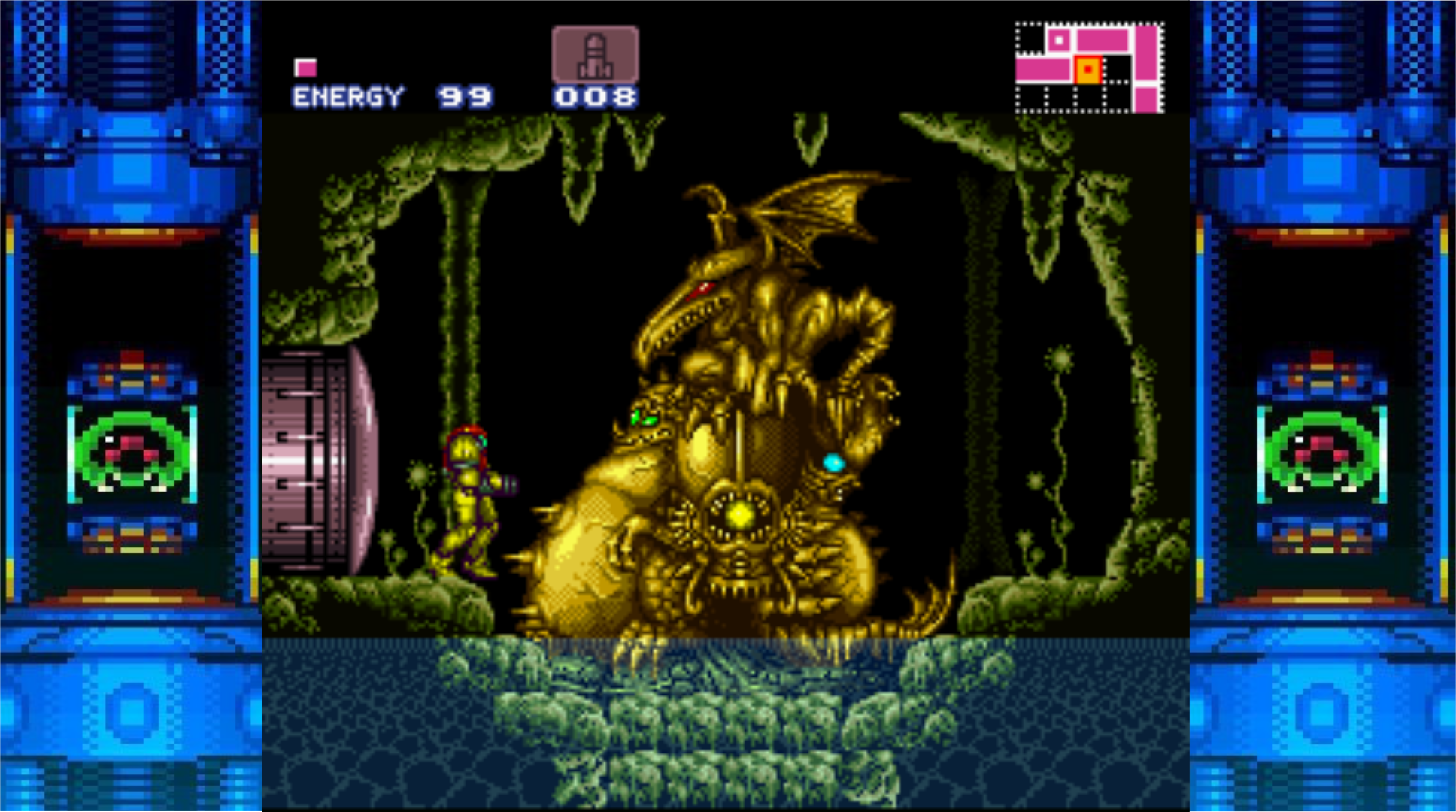
And the memorable landscapes only serve to enhance the power-ups as well. If I remember something from earlier in the game, collecting an item that could potentially interact with that something is exciting. The backtrack through alien-infested caverns becomes exciting, teasing me with the possibility of finally finding out the secret of a previously explored room.
Some of the secrets are still hidden behind destructible walls, but now indicators exist to help the player spot them. Sometimes enemies will creep through invisible walls. Sometimes you can see an area you can’t access, suggesting there’s a secret passage somewhere. I got stuck navigating through Zebes a few times, but I was always able to eventually figure out where I was supposed to go. Some secrets remain hidden behind obscure passages; however, you do receive a tool to assist you.
And the power-ups you receive are really exciting to use. There are familiar faces, like missiles, the morph ball, and my favorite friend, the screw attack. However, there are so many new abilities that open up both new platforming capabilities and new ways to destroy aliens. There’s the grapple beam, for example, which lets Samus swing from certain blocks and enemies. Samus also can obtain different power armor upgrades that allow her to traverse different terrains, like walking in lava.
The Most Minor of Complaints…
Everything was exciting to collect. However, not everything was quite so exciting to use. In theory, I loved every item in Super Metroid; in practice, not so much. The space jump is the best example of this. This particular item allows Samus to jump infinitely by timing your jump commands carefully. With this one power-up, the map opens up exponentially.
On paper, it’s such an awesome idea for a power-up. However, it’s a bit finicky. As I said, you have to time your button presses, but there’s no real indicator for when you should jump. You have to rely on muscle memory. No matter how long I practiced, I always found that I would drop inputs and plummet while climbing tall rooms.
Once again, I stress that the ability technically works and is mechanically a lot of fun, just a bit bothersome. I like to nitpick, especially in regards to the games I really enjoyed. Everything you collect works, and is super fun to use. Samus’ laser power-ups even stack this time. Collecting a new weapon type doesn’t cause you to drop your previous one; when you find the strongest weapon, the plasma beam, that beam can still freeze enemies if you had the ice beam previously.
Graphics – 10/10
Sound Design – 7/10
Gameplay – 8/10
Fun rating – 9/10
Overall – 8.5/10
Super Metroid is just an amazing game that holds up really well. It’s stylistically gorgeous and creates a horror-lite sci-fi world that’s a joy to explore. The controls are fluid, although a little janky, as the game has grown older. It’s still incredibly worth revisiting.
Pray For a True Peace in Space!
And that’s all we have time for this week (I say, asking politely for it to be forgotten that it’s been like three months since I last did this)! It’s been a long time since my last submission to this series of mine. The truth of the matter is that I’ve been playing a loooot of Ultimate and very little of anything else. We’re not finished with the Metroid universe yet; in fact, I have two more games to play.
Zero Suit Samus and Dark Samus don’t show up until Metroid Prime and its sequel, so I’ve penciled those in to play later. I started Prime, but I entered a bit of a Metroid burnout and wanted to move on to something else. Just know that it’s coming. I’m particularly excited to get around to it, seeing as Dark Samus has become one of my go-to characters for Smash online.
Also, I’m one of the many who are praying for a Prime collection to hit the Switch sometime soon. Finding good ways to play old Gamecube games is haaard! You know that if this game comes to my portable little baby, I’ll play it the second I can.
I guess, for now, I’m still just not ready to enter that third dimension yet.
Luke spent too many years getting a degree in Media Studies that he needs to justify, so now he’s here. He spends most of his time with charming cutesy indie platformers, overly cheesy video novels, or with his collection of ancient games that time has forgotten. If there’s one thing he strives to do above all else, it’s to complete games to 100%, although most of the time he gets halfway there and gets distracted by a shiny new title.
When he’s not playing video games, you can find him spending way too much time writing Dungeons & Dragons sessions, making podcasts, or failing to create academic readings of children's cartoons. He’s also Scottish, which he only mentions because Americans spell a lot of words wrong and his way is totally the right one.


